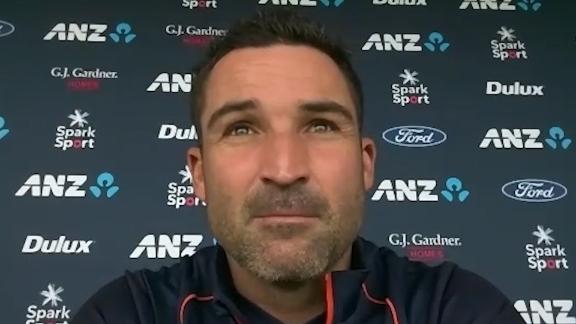South Africa 34 for 3 (Bavuma 22*, Southee 2-20) and 95 (Hamza 25, Henry 7-23) trail New Zealand 482 (Nicholls 105, Blundell 96, Henry 58*, Olivier 3-100) by 353 runs
Henry Nicholls scored his eighth Test century. Tom Blundell fell six short of his third. And Matt Henry continued his record-breaking ways, becoming the first No. 11 to score a fifty after taking a seven-for. All of which left South Africa with a mountain to climb in the first Test. New Zealand extended their lead to 387 and then reduced South Africa to 4 for 3 in the reply. On a surface that is just two days old and continues to offer good bounce and swing through the air, they will hope they've done enough to bat once.
Sarel Erwee, Dean Elgar and Aiden Markram were dismissed inside four overs in the second innings. Tim Southee rapped Erwee on the pads with his second ball, that swung in towards middle. Erwee considered reviewing but decided against it to end his debut Test with 10 runs. Elgar survived Henry's first over but when he scrambled the seam and angled it in from around the wicket, Elgar played and nicked off. Four balls later, Markram was stuck on the back foot and sent a thick edge to first slip. Of the three, Markram's place is most at risk. He averages 9.7 from his last 10 innings and could be replaced by Ryan Rickleton, who has scored three hundreds from his last first-class innings.
While South Africa's selection decisions could have contributed to their misfortune, their effort in the field definitely did. They dropped seven catches - four on the first evening and three on the second - including Nicholls on 5 and 24 on day one and Southee twice in the same over on day two - to underline an underwhelming performance. Their four-man pace attack, sans Lungi Ngidi who was ruled out with a back spasm, relied mainly on Kagiso Rabada and, without a specialist spinner, failed to hold up an end. Their lines and lengths were wayward as the inexperience of the 16 caps between Duanne Olivier, Marco Jansen and Glenton Stuurman showed, and their energy in the field was low.
By comparison, New Zealand did not just score big runs, they scored them quickly. Their 366 runs in 78.5 overs came at a rate of 4.64 on the second day thanks largely to Colin de Grandhomme and Blundell's 76-run seventh-wicket stand, which came at 5.49 to the over, and the late cameo by the final pair. Blundell and Henry put on 94 off 101 balls to frustrate South Africa after a long day in the field.
Things started poorly for the visitors as Wagner took on the role of early entertainer.
He hit seven fours and two sixes, all off South Africa's new-ball pair of Rabada and Stuurman. He cut Rabada for successive fours in two different overs, showing off perfect weight transfer to the back foot to flay the ball to an unmanned point region, and survived a review for lbw. Then he took on Stuurman's opening over of the day when he worked the second delivery off the hip to long leg, drove the third through the covers for four and then top-edged a hook off the penultimate ball for six. That shot brought up the fifty-run stand between Nicholls and Wagner - the third of four in New Zealand's innings. South Africa did not manage one partnership above 33.
But, the fun didn't last forever for Wagner. On 49, he attempted to flick Rabada over deep square leg but picked out Rassie van der Dussen instead. Despite Wagner's disappointment, he'd done his job and then some. When he was dismissed, New Zealand had scored 81 runs off 86 balls in the morning and Nicholls was responsible for just 23.
Wagner's aggression allowed Nicholls to collect runs almost unnoticed and he reached lunch on 87. His signature stroke through the morning was the punch through the point/third-man region and he ended up scoring more than a third of his runs - 40 out of his 105 - in that area. By the time Nicholls brought up his hundred, Stuurman had claimed his first Test wicket when Daryl Mitchell nicked off to Elgar at first slip. Nicholls' century came eight overs later, when he drove Olivier through backward point. In Olivier's next over, Nicholls reached for another drive, edged and was caught at second slip.
Nicholls was dismissed with the second new ball three overs away and South Africa may have been eyeing an opportunity to run through New Zealand's lower-order but de Grandhomme had other ideas. He took 11 runs off a Stuurman over with a swivel pull six and a whip through square leg and then hit Stuurman for back-to-back fours. Blundell unfurled a cover drive off Stuurman after two pin-point boundaries off Olivier and Elgar had run out of ideas to stem the tide.
He turned to Markram's part-time offspin with the second new ball just 9.4 overs old. It may have seemed an insult to the quicks but it worked. Shortly before tea, de Grandhomme holed out to long-on for 45 to give Markram his first wicket in this format. Makram got a second when Kyle Jamiseon was caught at mid-off but New Zealand were not done. Blundell's fifty came up with a pull off Jansen and he stuck with the tail to take the lead over 300. Southee was put down by Olivier at mid-on and van der Dussen at point and in between hit Rabada for four. A comical over ended when Southee hit the ball over Erwee at extra cover but the debutant backtracked and took a good catch over his head.
Enter Henry, who picked up career-best figures of 7 for 23 on the first day. He made a mockery of South Africa's weary attack with a 68-ball 58 which included a range of dismissive swats through the offside while Blundell showed off his late cuts and South Africa grew more and more despondent. As a measure of the one-sided nature of this game, the extras they had given away (35) by the time they bowled New Zealand out for 482 was higher than their top score (25) from the first innings.




